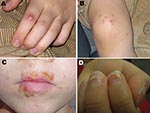
Vesicular eruptions in A) hand, B) foot, and C) mouth of a 6.5-year-old boy from Turku, Finland, with coxsackievirus (CV) A6 infection. Credit - CDC EID Journal
# 6250
As a follow up to a blog I wrote in February (see HFMD: An Old Illness With A New Cause), today we’ve a field report that appears in the current MMWR on an emerging coxsackievirus (CVA6) that has recently been reported in the United States.
HFMD (Hand Foot & Mouth Disease) is a very common viral infection, usually peaking late summer or early fall, and mainly seen among children under the age of 10 (although adults may be vulnerable as well).
It is caused by several of the non-polio enteroviruses.
The two most common causes of HFMD have been the Coxsackie A16 virus, and the Enterovirus-71 (EV-71), and rarely, the Coxsackie A10 virus.
The disease in the United States is commonly caused by the Coxsackie A16 virus and is generally mild. Outbreaks are not uncommon in schools and childcare facilities.
In 2008, the CDC’s EID Journal carried a dispatch describing an outbreak of HFMD in Finland due to an unusual, and apparently emerging, viral cause; the Coxsackie A6 (CVA6) virus.
Since then, we’ve seen a growing number of reports of HFMD outbreaks around the world due to this particular coxsackievirus, but until this winter, never in the United States.
Today’s MMWR brings us details of the spread and severity of these cases.
As they note: The age ranges of patients, severity of illness, seasonality of disease, and identification of CVA6 in these cases were unusual for HFMD in the United States.
The good news is - while more severe than typical HFMD, and resulting in the hospitalization of nearly 20% of the cases - no deaths from the emerging CVA6 strain were reported.
Notes from the Field: Severe Hand, Foot, and Mouth Disease Associated with Coxsackievirus A6 — Alabama, Connecticut, California, and Nevada, November 2011–February 2012
Weekly
March 30, 2012 / 61(12);213-214Hand, foot, and mouth disease (HFMD) is a common viral illness caused by enteroviruses that predominantly affects children aged <5 years. In the United States, outbreaks of HFMD typically occur during summer and autumn months. The most common cause of HFMD in the United States has been enterovirus serotype coxsackievirus A16. Most infections are asymptomatic; persons with signs and symptoms typically have a mild febrile illness with rash on the palms of the hands and soles of the feet, and sores in the mouth. HFMD also has been associated, often weeks after initial symptom onset, with nail dystrophies (e.g., Beau's lines or nail shedding).
From November 7, 2011, to February 29, 2012, CDC received reports of 63 persons with signs and symptoms of HFMD or with fever and atypical rash in Alabama (38 cases), California (seven), Connecticut (one), and Nevada (17). HFMD is not a reportable disease in the United States; the cases were identified as unusual by health-care providers or by a department of health that contacted CDC for diagnostic assistance. Clinical specimens were collected from patients in 34 of the 63 cases. Coxsackievirus A6 (CVA6) was detected in 25 (74%) of those 34 patients by reverse transcriptase–polymerase chain reaction and partial sequencing of the VP1 gene at CDC or at the California Department of Public Health. No enteroviruses were detected in the other nine patients.
Of the 63 patients, 40 (63%) were aged <2 years, and 15 (24%) were adults aged ≥18 years; 44 (70%) of the patients had exposure to a child care facility or school, and eight (53%) of the 15 adults had contact with children in child care where cases of HFMD were reported, or provided medical care or were related to a child with HFMD. Rash and fever were more severe, and hospitalization was more common than with typical HFMD. Signs of HFMD included fever (48 patients [76%]); rash on the hands or feet, or in the mouth (42 [67%]); and rash on the arms or legs (29 [46%]), face (26 [41%]), buttocks (22 [35%]), and trunk (12 [19%]). Of 46 patients with rash variables reported, the rash typically was maculopapular; vesicles were reported in 32 (70%) patients and scabs in 30 (65%) patients. Shedding of nails occurred after initial infection in two (4%) patients. Of the 63 patients, 51 (81%) sought care from a clinician, and 12 (19%) were hospitalized. Reasons for hospitalization varied and included dehydration and/or severe pain. No deaths were reported.
The age ranges of patients, severity of illness, seasonality of disease, and identification of CVA6 in these cases were unusual for HFMD in the United States. CVA6 has been associated with more severe and extensive rash than HFMD caused by other enteroviruses (1). Since 2008, international outbreaks of CVA6 HFMD in children and adults have been described (1–4), but no outbreaks had been reported in the United States previously. Although all 25 of the CVA6 strains identified in the U.S. cases were genetically closely related (based on partial VP1 gene sequences) to CVA6 strains identified in recent international outbreaks, no epidemiologic evidence (e.g., travel history) has directly linked any of the U.S. cases to importation.
HFMD is spread from person to person by contact with saliva, respiratory secretions, fluid in vesicles, and feces. Transmission of HFMD can be reduced by maintaining good hygiene, including handwashing and disinfection of surfaces in child care settings (5). CDC continues to receive reports of CVA6-associated HFMD. Persons who suspect a severe case of HFMD should contact their health-care provider. Local or state health departments may contact CDC for assistance with enterovirus laboratory diagnosis.
For more on HFMD, including the more severe Enterovirus-71 (EV-71) version found mostly in southeast Asia, you may wish to revisit the following blogs:
Vietnam’s HFMD Outbreak
China: A Recombinant EV-71
HFMD Rising In China
China Sounds Alert Over EV-71 Virus
Related Post:
Widget by [ Iptek-4u ]